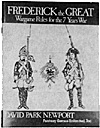 This was written by David Park Newport. It is
published by Fantasy Games Unlimited, Inc. The rules
cover the entire 18th century. The figure scale is 1:50. The
number of artillery pieces is represented by artillery crew
figures, each figure equaling 2 real guns. The ground scale
is one inch equals 50 yards. One turn represents 10
minutes real time. All dice rolls require two 20-sided dice.
This was written by David Park Newport. It is
published by Fantasy Games Unlimited, Inc. The rules
cover the entire 18th century. The figure scale is 1:50. The
number of artillery pieces is represented by artillery crew
figures, each figure equaling 2 real guns. The ground scale
is one inch equals 50 yards. One turn represents 10
minutes real time. All dice rolls require two 20-sided dice.
The base sizes are determined by the number of figures in a company or squadron. Each regular infantry figure requires a frontage of 1/2", light infantry and artillerists require 3/4" and cavalry needs 1". A point system is presented based on armament, morale class and command points.
Battalions of foot are organized into regiments. The first battalion of a regiment gets advantages in melee and morale. Loss of colors, which are carried by the first battalion, can be demoralizing for the regiment. The unit capturing an enemy's color gets a morale bonus.
Units are grouped into brigades. Usually a brigade consists of units from the same regiment. Each brigade is given strategic orders at the beginning of the game. Tactical orders are written each turn for each battalion, cavalry squadron, regiment, or detached companies.
The sequence of play is rather involved, especially if there is a charge. However, it does help decide who can fire at whom and when. Simultaneous movement and fire is used. A detailed section on permitted actions is given.
This is very straight forward and prevents any arguments concerning what a unit can and cannot do. Field constructions are allowed, such as building ditches, soft and hard cover, and fortifications. Allowable formations are discussed in detail as well as terrain effects.
Artillery fire is very detailed. Guns are classified by poundage. Artillery is allowed a double fire under certain conditions. Small arms fire effect depends on the range, weapon, and morale class of the firer. Bow fire is also covered.
There is a first fire bonus and a special table for firing when charged. Casualties are given in numbers of figures down to the nearest hundredth. Fractional figures are killed if the proper value is rolled on ~ the 20-sided dice. I
Melee is based on a comparison of relatives values for armor, order, morale, tactical situation, and the roll of the percentage dice. The latter is too variable and some wild melee results can happen. There are 4 1/2 pages covering melee examples which helps clear things up.
Morale involves throwing two twenty-sided dice (1-100) and then adding and subtracting modifiers. The net result is compared to a chart. The melee reaction of the unit depends on the morale class of the testing unit. Several morale checks may be required during the turn, especially if more than one figure is lost. An uncontroiled advance is possible to cavalry and B, C, and D class infantry. I saw a game where French cavalry charged across the board at British foot and were slaughtered by a first volley (Minden revisited!).
Optional rules cover more detailed fortification rules, weather, conversion to 1:20 figure ratio (highly recommended for the AWI), and using a roster system. The Appendix includes organization for all of the SYW participants with percentage composition. It also has organization for the AWI. There are some special rules for the Marlborough period.
Finally, the rules have three cards printed back and front with a synopsis of the rules. Take heed there are some conflicts between the cards and the rules. Also all three cards are required so there is a lot of card shuffling trying to find the correct table.
I have tried these rules and find them to be very quick playing if the players are familiar with the system. Some house rules are in order though. Battalion guns move too slowly. Also there is no provision for maintaining the 1st company on the right flank as was prevalent during the 18th century.
All the rules which have just been reviewed contain provisions for 15mm figures. All distances are halved in order to accomadate the smaller figures.
The Rules
-
7YW Rules Introduction
7YW Rules Tricorne
7YW Rules Wargame Rules 1685-1845
7YW Rules Mitre, Mustache, and Musket
7YW Rules Frederick the Great
7YW Rules Ken Bunger Comments
Back to Table of Contents -- Courier Vol. 2 #3
To Courier List of Issues
To MagWeb Master Magazine List
© Copyright 1980 by The Courier Publishing Company.
This article appears in MagWeb (Magazine Web) on the Internet World Wide Web.
Other military history articles and gaming articles are available at http://www.magweb.com